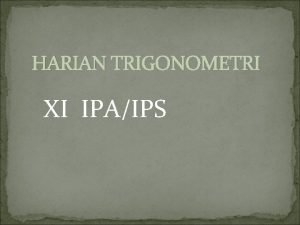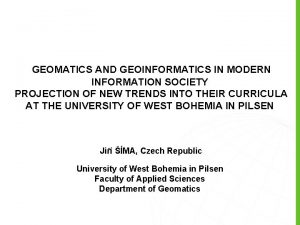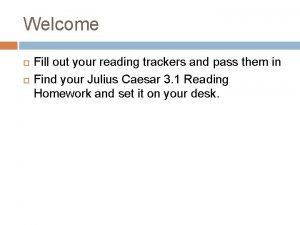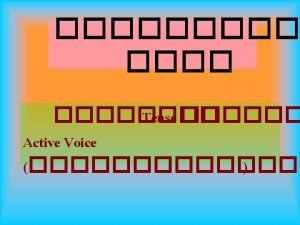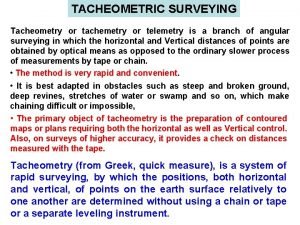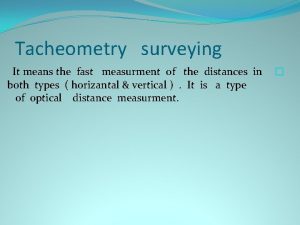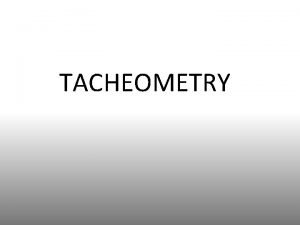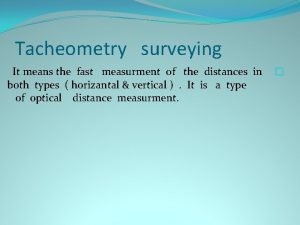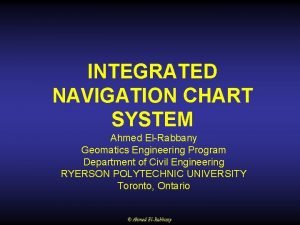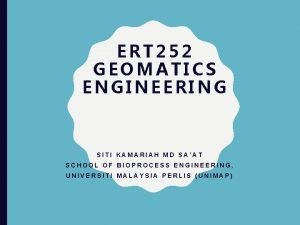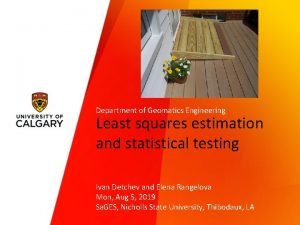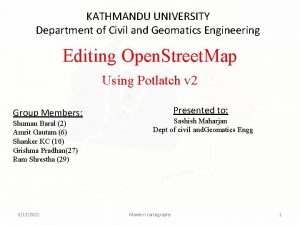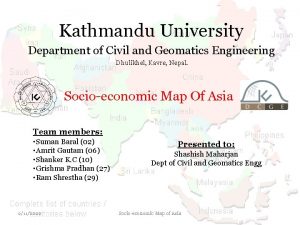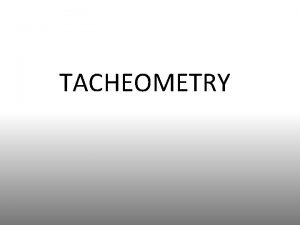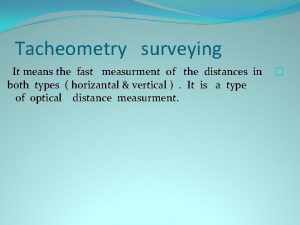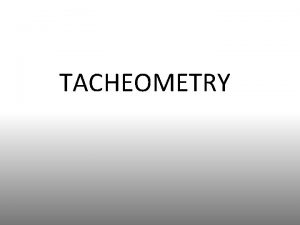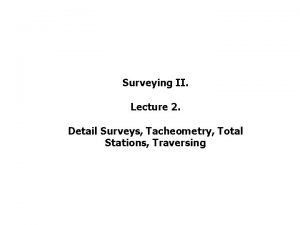EAT 112 GEOMATICS ENGINEERING TACHEOMETRY Part 1 Mr























- Slides: 23

EAT 112 – GEOMATICS ENGINEERING TACHEOMETRY - Part 1 Mr MOHD FAIZ B MOHAMMAD ZAKI LECTURER SCHOOL OF ENVIRONMENT ENGINEERING

INTRODUCTION • Tacheometry (or Tachemetry or Telemetry) is a branch of angular surveying in which the horizontal and vertical distances of points are obtained by optical means as opposed to the ordinary slower process of measurements by tape or chain.

CONT… • The method is very rapid and convenient. Although the accuracy of tacheometry unfavourably compared to chaining method, it is best adapted in obstacle such as steep and broken ground, deep ravines, stretches of water or swamp and so on, which make chaining difficult or impossible.

USES OF TACHEOMETRY • Preparation of topographic maps which require both elevations and horizontal distances. • Survey work in difficult terrain where direct methods are inconvenient • Detail filling • Reconnaissance surveys for highways, railways, etc.

INSTRUMENTS • The Tacheometer - It is nothing but a transit theodolite fitted with a stadia diaphragm and an anallatic lens.

CONT… • The Levelling Staff and Stadia Rod - For short distances, ordinary levelling staves are used. The levelling staff is normally 4 m long and can be folded into three parts. • For long sights a specially designed graduated rod is used. which is known as stadia rod. It is also 4 m long. The graduations are comparatively bold and clear.

CHARACTERISTIC OF TACHEOMETER • The value of the multiplying constant f/i should be 100. • The telescope should be powerful, having a magnification of 20 to 30 diameters. • The aperture of the objective should be of a 35 to 45 mm diameter for there to be a bright image. • The telescope should be fitted with an anallatic lens to make the additive constant (f + d) exactly equal to zero. • The eye-piece should be of greater magnifying power than usual, so that it is possible to obtain a clear staff reading from a long distance.

PRINCIPLE OF TACHEOMETRY • The principle of tacheometry is based on the property of isosceles triangles, where the ratio of the distance of the base from the apex and the length of the base is always constant.

CONT… • The constant f/i is known as the multiplying constant where , f = focal length of objective and i = stadia intercept.

CONT…

By adopting an anallatic lens in the telescope of a tacheometer, the multiplying constant is made 100, and the additive constant is zero. However, In some tacheometers, the addi tive constants are not exactly zero, It vary from 30 cm to 60 cm (which are generally mentioned in the catalogue supplied by the manufactured). Additive constant Multiplying constant

METHODS OF TACHEOMETRY • Tacheometry involves mainly two methods: • The stadia method • The tangential method.

STADIA METHOD • In this method, the diaphragm of the tacheometer is provided with two stadia hairs (upper and lower). Looking through the telescope the stadia hair readings are taken. • The difference in these readings gives the staff intercept. To determine the distance between the station and the staff, the staff intercept is multiplied by the stadia constant (i. e. multiplying constant, 100). The stadia method may, in turn, be of two kinds • The Fixed Hair Method • The Moveable Hair Method

THE FIXED HAIR METHOD • The distance between the stadia hairs is fixed in this method which is the one commonly used. When the staff is sighted through the telescope, a certain portion of the staff is intercepted by the upper and lower stadia. • The value of the staff intercept varies with the distance. However, the distance between the station and the staff can be obtained by multiplying the staff intercept by the stadia constant.

THE MOVEABLE HAIR METHOD • The stadia hairs are not fixed in this method. They can be moved or adjusted by micrometer screws. • The staff is provided with two targets or vanes a known distance apart. During observation, the distance between stadia hairs is so adjusted that the upper hair bisects the upper target and the lower hair bisects the lower target. • The variable stadia intercept is measured and the required distance is then computed. This method is not generally used.

THE TANGENTIAL METHOD In this method. the diaphragm of the tacheometer is not provided with stadia hair. The readings are taken by the single horizontal hair. The staff consists of two vanes or targets a known distance apart. To measure the staff intercept, two paintings are required. The angles of elevation or depression arc measured and their tangents are used for finding the horizontal distances and elevations. This method is also not generally used. The stadia method requires only one observation, but the tangential method requires two pointings of the telescope.

FIXED HAIR METHOD -Case 1 • . The multiplying constant is 100, and the additive constant is zero.

FIXED HAIR METHOD -Case 2 When line of sight is inclined, but staff is held vertically. Here, the measured angle may be the angle of elevation or that of depression.

CONT…

FIXED HAIR METHOD -Case 3.

CONT…

WORKED-OUT PROBLEMS 1 A tacheometer was set up at a station C and the following readings were obtained on a staff vertically held. INST. STATION STAFF STATION C BM C D VERTICAL ANGLE HAIR READINGS (m) -5 O 20’ +8 O 12’ REMARK 1. 150, 1. 800, 2. 450 RL of BM 0. 750, 1. 500, 2. 250 = 750. 50 m Calculate the horizontal distance CD and RL of D, when the constants of instrument are 100 and 0. 15.

WORKED-OUT PROBLEMS 2
 Geodesy and geomatics engineering
Geodesy and geomatics engineering Nilai dari 8 sin 112,5° cos 22,5° =
Nilai dari 8 sin 112,5° cos 22,5° = Geomatics and geoinformatics
Geomatics and geoinformatics Uesi surveying & geomatics conference
Uesi surveying & geomatics conference I would rather eat potatoes than eat rice
I would rather eat potatoes than eat rice I eat, you eat, he eats
I eat, you eat, he eats People buy me to eat
People buy me to eat Uses of tacheometric surveying
Uses of tacheometric surveying Tacheometry
Tacheometry Types of tacheometry
Types of tacheometry Stadia distance formula
Stadia distance formula Tacheometry surveying
Tacheometry surveying Part part whole addition
Part part whole addition Unit ratio definition
Unit ratio definition Part part whole
Part part whole Technical description examples
Technical description examples Parts of bars
Parts of bars The phase of the moon you see depends on ______.
The phase of the moon you see depends on ______. Part to part variation
Part to part variation Poli 112
Poli 112 Hbu118
Hbu118 Sr 112 west (17th ave) toll
Sr 112 west (17th ave) toll Psalm 112:5
Psalm 112:5 Project 112
Project 112

